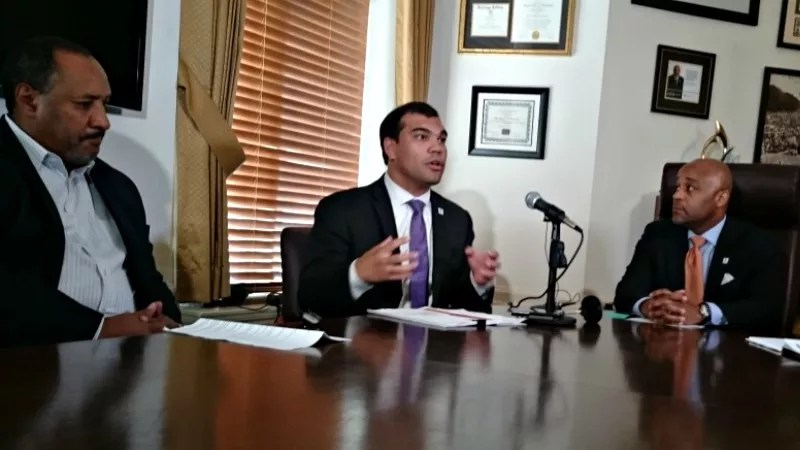
Michael Roberts

Audio By Carbonatix
Today, September 29, Denver Mayor Michael Hancock formally unveiled a draft document of Denver’s new proposed five-year housing plan. “Housing an Inclusive Denver,” accessible below, aims to address the have-nots as well as the haves in the go-go economy of today’s Mile High City. Despite the apparent good times, Hancock acknowledged that “people are being squeezed out.”
Aside from Hancock, the main players at a press briefing held at the mayor’s office at Denver’s City and County Building were Erik Soliván, executive director for the Office of Housing and Opportunities Everywhere, shorthanded as HOPE, and Kevin Marchman, who chairs the city’s Housing Advisory Committee. Their purpose was to provide an overview of the massive document, 98 pages worth of facts, figures and goal-setting that’s long on ambition. And problems that need addressing aren’t dodged.
At present, the proposal states, Denver has approximately 140,000 rental units, with around 21,000 of them, or about 15 percent of the total, under restrictions that keep them in the affordable range. However, the plan goes on, “more than 2,200 affordable homes are at risk of becoming unaffordable over the next five years if the existing income restrictions expire and owners can rent the units at market rate prices. The city could lose its existing affordable housing stock if income restrictions expire, and families living in these affordable units are also at risk of displacement if the building converts to market rate pricing that is unaffordable to existing families.”
In addition, the doc acknowledges that renters who live in unsubsidized housing remain “vulnerable to rent increases that could become unaffordable and threaten to displace existing tenants. Feedback collected through the community engagement process for this plan indicated that many renters are living on month-to-month leases, that living conditions in some unsubsidized properties are substandard, and that evictions are becoming increasingly prevalent. While Colorado has made some changes at a state level to enhance notice to residents when they are required to vacate a rental property, many low- and moderate-income families that receive such a notice are left with limited options.”
Denver, make your New Year’s Resolution Count!
We’re $13,000 away from reaching our $50,000 year-end fundraising goal. Your support could be what pushes us over the top. If our work has kept you informed and connected this year, please consider making a contribution today.
And that’s not to mention the local homeless population. In January, 3,336 households “reported experiencing homelessness on a given night in Denver,” the plan states. Statistics showed 471 households described as “newly homeless,” 701 defined as “chronically homeless,” 457 involving veteran,s and 267 pertaining to “unaccompanied youth.”

Kevin Marchman, Erik Soliv
Michael Roberts
At the briefing, Hancock, Soliván and Marchman didn’t treat affordable housing and homelessness as separate issues. “This is not just about housing,” Hancock stressed, but also “good homes, good jobs and good health.”
Soliván, for his part, focused on a overarching question: “How do we move Denver forward?” This issue is addressed in broad strokes in the plan’s list of four “fundamental values”:
• Leverage and enhance housing investments with resources from public, private and nonprofit partners to support inclusive communities in Denver, including a focus on sustainability of the City’s existing resources for affordable housing development, preservation and programs.
• Foster communities of opportunity by aligning housing strategies and investments with unique neighborhood conditions that consider five opportunity outcomes: stable and affordable homes, jobs and economic mobility, comprehensive health services, access to quality education, and mobility and transit connections.
• Support housing as a continuum that serves residents across a range of incomes, including residents experiencing homelessness, those earning low wages or living on fixed-incomes such as seniors or residents with a disability, and working families.
• Embrace diversity throughout neighborhoods to ensure that Denver remains a welcoming community for all residents by focusing on policies, programs and investments that support inclusive, mixed-income communities.
Also key are the so-called “core goals”:
• Create affordable housing in vulnerable areas AND in areas of opportunity by focusing on production that considers specific neighborhood conditions, including areas vulnerable to displacement and neighborhoods that have strong amenities such as transit, jobs, high-quality education and health care. Measurable outcomes from investment and policies under this core goal include new units created.
• Preserve affordability and housing quality by investing to maintain affordability in nonsubsidized units and preserving or continuing affordability of existing publicly subsidized affordable housing. Measurable outcomes from investment and policies under this core goal include existing units preserved and residents served through program investments or policy actions.
•Promote equitable and accessible housing options by supporting programs and policies that help residents across the housing continuum access affordable housing. Measurable outcomes from investment and policies under this core goal include residents served through program investments or policy actions.
•Stabilize residents at risk of involuntary displacement by supporting programs and policies that help a resident maintain their existing housing or stay in their community. Measurable outcomes from investment and policies under this core goal include residents served through program investments or policy efforts.
These objectives aren’t free of politics. Hancock responded to people “who say, ‘What are you doing? You’re not doing enough'” by stressing that he hasn’t been asleep at the switch as the affordable-housing situation in Denver worsened. For instance, he noted that nearly 5,000 units have come on line since 2013.
Likewise, Soliván pointed out that there is already some funding available to assist financially challenged renters, including those who’ve been evicted, but the new plan would free up more – up to $1 million.
A public-comment period for the plan will run through November 13. Click to access the “Housing an Inclusive Denver” public-review draft and to share your views.